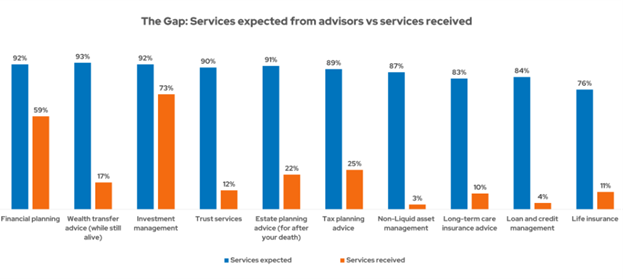How Much Do You Really Need to Retire?
Resources
How Much Do You Really Need to Retire?

Why “rules of thumb” may fall short — and how DLAK’s approach helps bring clarity through simple math and personalization.
It’s one of the most common questions we hear: “How much do I actually need to retire?”
A quick search online gives you a dozen different answers — most of them framed as neat, round rules of thumb. Fidelity says you should aim for ten times your annual income by age 67. Others tell you to withdraw 4% per year and call it a day. These ideas make for good headlines, but they rarely hold up once real lives and real markets get involved.
Take Fidelity’s “10x rule” as an example. If you have a pension and two Social Security incomes, that target becomes meaningless — your guaranteed income sources already change the math entirely.
At DLAK, we’re not saying our approach is better; we’re saying it’s different. We believe financial planning shouldn’t be about chasing formulas created in a vacuum. It should be about applying logic, structure, and math to your actual circumstances — not someone else’s averages.
Why “Monte Carlo” and Rules of Thumb may Miss the Mark
Most big financial firms rely on a process called Monte Carlo simulation. It sounds impressive, and in theory, it’s useful: the model runs thousands of potential market paths to estimate your “probability of success” in retirement. But the problem is that these models are only as good as their assumptions — and those assumptions are usually based on long-term averages that don’t reflect individual needs.
A Monte Carlo analysis might tell you there’s a 90% chance your plan “succeeds.” But what does that actually mean? It doesn’t tell you when your money might run low, or how your personal spending patterns, risk comfort, or market valuations affect that probability. It also assumes retirement starts at a single point in time — yet for many people, the definition is blurry. Is “retirement” the day you stop working, or the day all your guaranteed income sources begin? The 4% rule and other “success rate” models often miss that distinction.
Financial planning doesn’t need to be abstract. It just needs to be clear.
The DLAK Framework: Real Math, Real Personalization
Instead of relying on generic assumptions, DLAK’s approach focuses on something much more tangible: how long your money will last under different distribution rates.
To illustrate, let’s assume:
- 5% annual growth on investments – a deliberately conservative rate of return, designed to reflect long-term, risk-adjusted expectations rather than optimistic projections
- 2.5% inflation, meaning withdrawals rise each year to keep up with cost of living
- Withdrawals beginning at the point an individual starts taking income, rather than a fixed retirement age
Then, we model how long that money lasts under different initial distribution rates:
|
Initial Distribution Rate |
Years Until Money Runs Out |
|
7.0% |
18 years |
|
5.75% |
23 years |
|
4.8% |
29 years |
|
4.0% |
38 years |
|
3.5% |
48 years |
|
3.0% |
66 years |
|
2.7% |
89 years |
|
2.35% |
Never |
This simple progression makes the tradeoffs clear. A higher distribution rate shortens your runway — dramatically. A lower one gives your portfolio endurance, sometimes indefinitely.
But we don’t stop there — we also stress test each scenario. Roughly 80% of outcomes may turn out better than projected, but 20% could be worse. We model those less likely situations — prolonged market downturns, higher inflation, or delayed recoveries — so clients can see what happens if the unexpected occurs.
For example, at a 3% initial distribution rate, the baseline projection lasts about 66 years. But if five years into retirement the portfolio experiences two consecutive years of –5% returns instead of the assumed +5%, the money would last 47 years instead. Or, if inflation averages 3% instead of 2.5%, that same portfolio would last about 53 years.
These are not predictions — they’re illustrations of how resilient (or vulnerable) a plan may be when reality strays from the averages.
Rather than hiding behind opaque simulations, we show clients the math directly: what each withdrawal rate means in practical terms, how long the money is likely to last, and what level of risk aligns with their comfort and timeline.
Four Factors That Define Your Risk
Our Risk Analyzer helps personalize this further by combining four key inputs:
- Retirement year: How soon you plan to retire sets your baseline allocation — the closer you are, the more conservative your starting point.
- Personal comfort with risk: Rated 1–10. A “10” tilts your portfolio toward more opportunity (e.g., 100/0 allocation), while a “1” emphasizes preservation (around 0/100).
- Time until portfolio drawdown: This determines how much flexibility your plan truly has. Someone who will use most of their money within 10 years needs stability; someone who won’t touch most of it for 20+ years can afford to take more risk.
- Market valuations: When markets are expensive, we pull back risk; when they’re undervalued, we lean in.
Together, these inputs replace guesswork with logic. They make risk a reflection of your plan — not just your age.
The 7-Year Rule: Protect What You’ll Need Soon
A cornerstone of DLAK’s retirement philosophy is what we call the 7-Year Rule:
Any money you expect to withdraw in the next seven years should not be in the stock market.
If you plan to draw $50,000 a year, typically that means at absolute minimum $350,000 should be allocated to bonds or other fixed investments. This protects the portion of your assets that funds near-term spending, while allowing the rest the opportunity to participate in long-term growth.
It’s a simple principle — but it’s often overlooked by models that treat every dollar the same.
The Bottom Line: Simplicity Over Sophistication
Fancy models and buzzwords make for great marketing, but they often obscure what really matters: time, math, and discipline.
At DLAK, we don’t claim our process is superior — just that it’s more transparent. Retirement planning shouldn’t depend on generalized “success probabilities” or arbitrary savings multiples. It should be grounded in personalized math — understanding how long your money truly needs to last, how much risk that timeline can support, and how to structure withdrawals accordingly.
Technology can be useful, but it can also create a false sense of certainty or insecurity. Real clarity comes not from algorithms, but from aligning your plan with the simple math of your life — and that’s exactly what we do every day.
Disclosure:
This material contains the current opinions of Robert Koscik and his team but not necessarily those of Guardian or its subsidiaries and such opinions are subject to change without notice. Any chart and graph are for illustrative purposes and are not intended to suggest a particular course of action or represent the performance of any particular financial product or security. Past performance is not a guarantee of future results. This material is intended for general public use. By providing this content, Park Avenue Securities LLC and your financial representative are not undertaking to provide investment advice or make a recommendation for a specific individual or situation, or to otherwise act in a fiduciary capacity.
Data and rates used were indicative of market conditions as of the date shown. Opinions, estimates, forecasts, and statements of financial market trends are based on current market conditions are subject to change without notice. References to specific securities, asset classes and financial markets are for illustrative purposes only and do not constitute a solicitation, offer, or recommendation to purchase or sell a security. Guardian, its subsidiaries, agents, and employees do not provide tax, legal, or accounting advice. Consult your tax, legal, or accounting professional regarding your individual situation. Tax laws are always subject to change.
Securities products and advisory services offered through Park Avenue Securities LLC (PAS), member FINRA, SIPC. OSJ: 419 Plum Street; Cincinnati, OH 45202. Phone: (513) 579-1114. PAS is a wholly owned subsidiary of The Guardian Life Insurance Company of America (Guardian), New York, NY. DLAK Wealth Advisors LLC is not an affiliate or subsidiary of PAS or Guardian and is not registered in any state or with the U.S. Securities and Exchange Commission as a Registered Investment Advisor. 8600066.1 Exp 11/27
- Created on .




